PsychNewsDaily Publishers
100 Summit Drive
Burlington, MA, 01803
Telephone: (320) 349-2484
PsychNewsDaily Publishers
100 Summit Drive
Burlington, MA, 01803
Telephone: (320) 349-2484
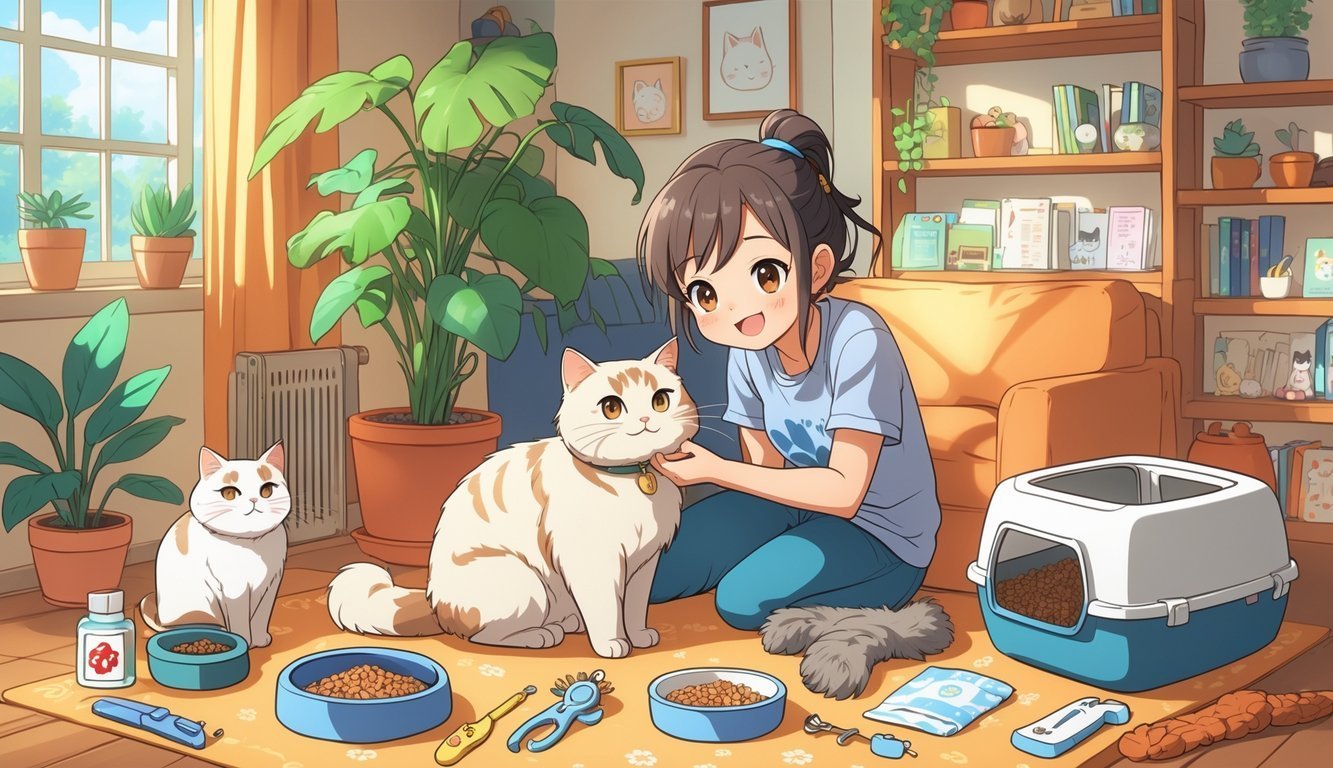
Bringing a cat home is exciting, but let’s be honest—it comes with a few surprises and responsibilities you might not have seen coming. You want your cat to feel safe, healthy, and happy right from the start, so it’s smart to get the basics sorted out before anything goes sideways.
Knowing what your cat truly needs from day one helps you avoid stress and costly mistakes later.
Let’s talk about setting up a comfy space, picking out the right supplies, and making your home safe for your new feline friend. This guide covers the basics every new cat owner should have on their radar, so your kitty can settle in and thrive.
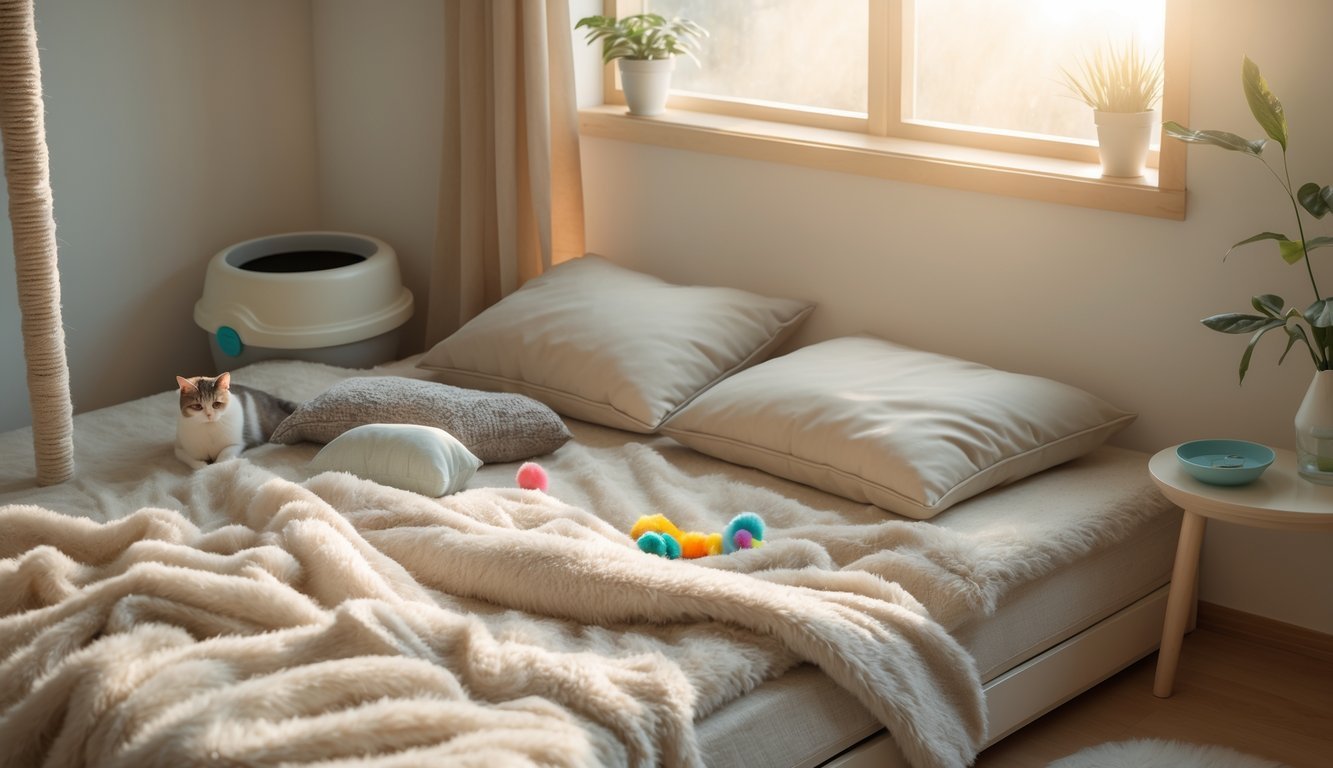
Your cat will feel safer if you give them a calm space of their own. Pick a quiet room or a tucked-away corner, somewhere far from heavy foot traffic and loud noises.
This helps reduce stress, especially when your cat is still figuring out their new home. Place a soft bed or a cozy blanket in that spot.
Cats love warmth and comfort, so a plush bed or even a folded-up old shirt with your scent can work wonders. If you already have something that smells like you, toss it in there—it helps the space feel familiar.
Keep the area simple but inviting. Maybe add a scratching post, a couple of toys, and a water dish nearby.
Try not to clutter things up, so your cat has room to stretch out and relax. Make sure this spot stays the same.
Cats really lean on routine, so a stable resting area helps them feel secure. Over time, you’ll probably find your cat heading back to this cozy place whenever they want to nap or just escape the noise.
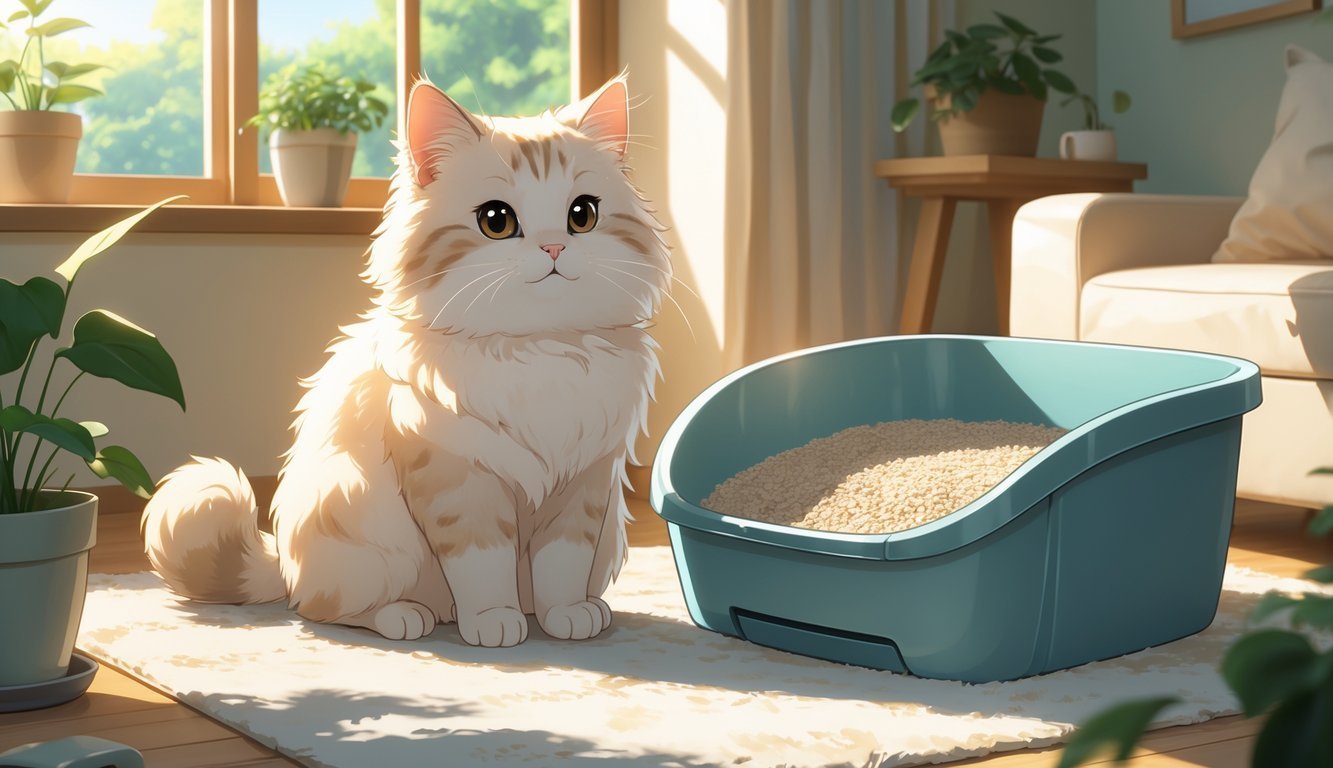
Picking the right cat litter makes daily life a whole lot easier. Good litter cuts down on odor, keeps the box cleaner, and encourages your cat to actually use it.
Dr. Elsey’s Precious Cat is a favorite for a reason. They offer different formulas for things like multiple cats, low dust, or even picky cats who sometimes avoid the box.
They make their litter from high-quality clay that clumps well, so scooping is quick and not a huge chore. That means you don’t have to dump the entire box as often.
If your cat has breathing sensitivities, try a low-dust formula to make the air around the box feel fresher. Got more than one cat? The multi-cat version is built for heavier use.
Matching the litter to your cat’s needs makes the box more appealing. This small change can prevent accidents around the house and keep your cat comfortable.
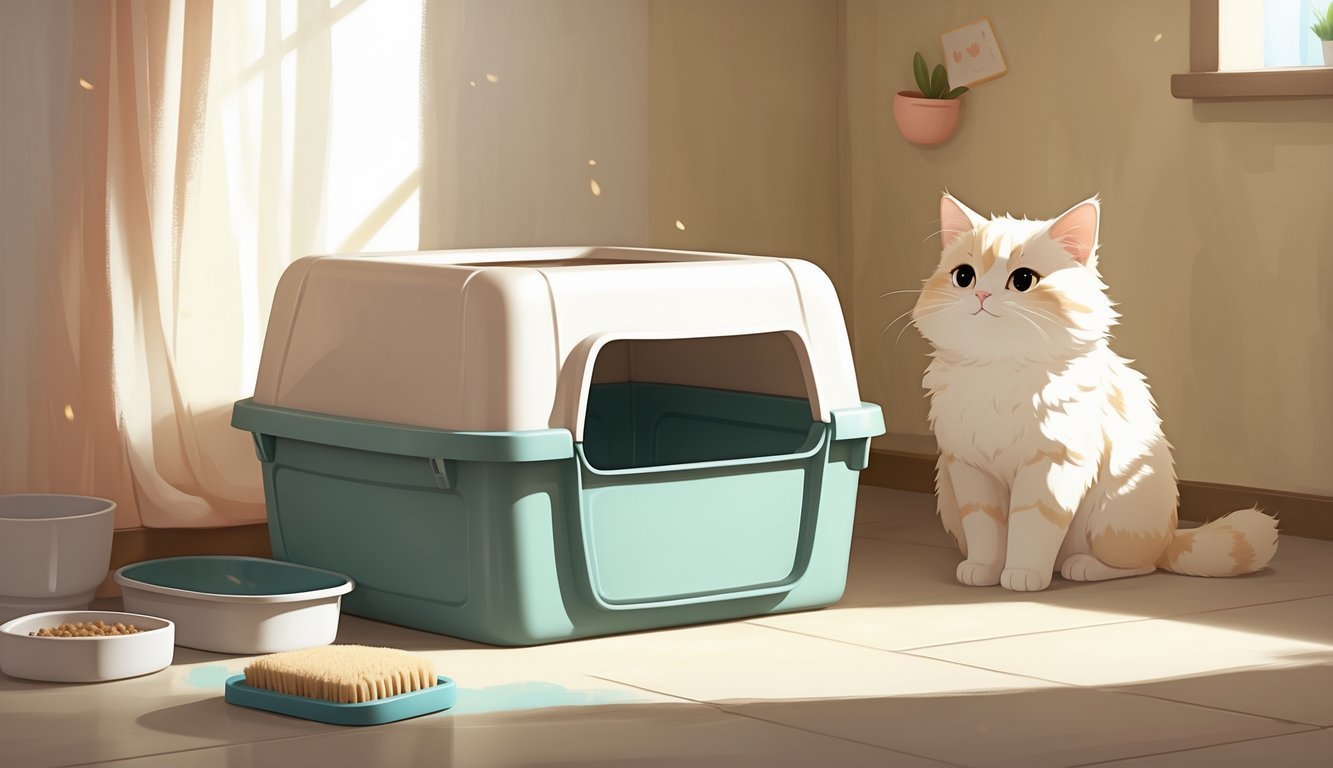
A sturdy litter box with high sides saves your floors from stray litter. Cats love to dig, and taller walls keep most of the mess inside the box.
If your cat tends to spray, those high sides help keep everything contained. This is especially handy if you’ve got a male cat or one who likes to aim high.
Pick a box that’s roomy enough for your cat to move around. Cramped boxes turn cats off, and you don’t want them looking for a new bathroom spot.
Look for smooth plastic or stainless steel—something that’s easy to clean. Non-stick surfaces make scooping less of a pain.
Rounded corners also help, since clumps won’t get stuck as easily. Place the litter box in a quiet part of your home.
Cats like privacy, and a calm spot encourages regular use. Keep it out of busy walkways, but make sure it’s still easy for your cat to reach.

What you feed your cat really matters. Brands like Royal Canin and Hill’s Science Diet have built their reputations on nutrition for different life stages and health needs.
You’ll find options for kittens, adults, and seniors. Both brands also offer recipes for weight control, sensitive tummies, or urinary health.
Royal Canin often designs food for specific breeds or medical issues. Hill’s Science Diet leans on research for their general wellness formulas.
Vets recommend both pretty often, so you’re in good hands either way. Price can play a role—Hill’s usually costs a bit less, while Royal Canin might have more specialized choices.
Pick what matches your cat’s health, taste, and your budget. No matter what, follow the feeding guidelines on the bag.
Always make sure your cat has fresh water, and if you’re not sure about the best formula, ask your vet.
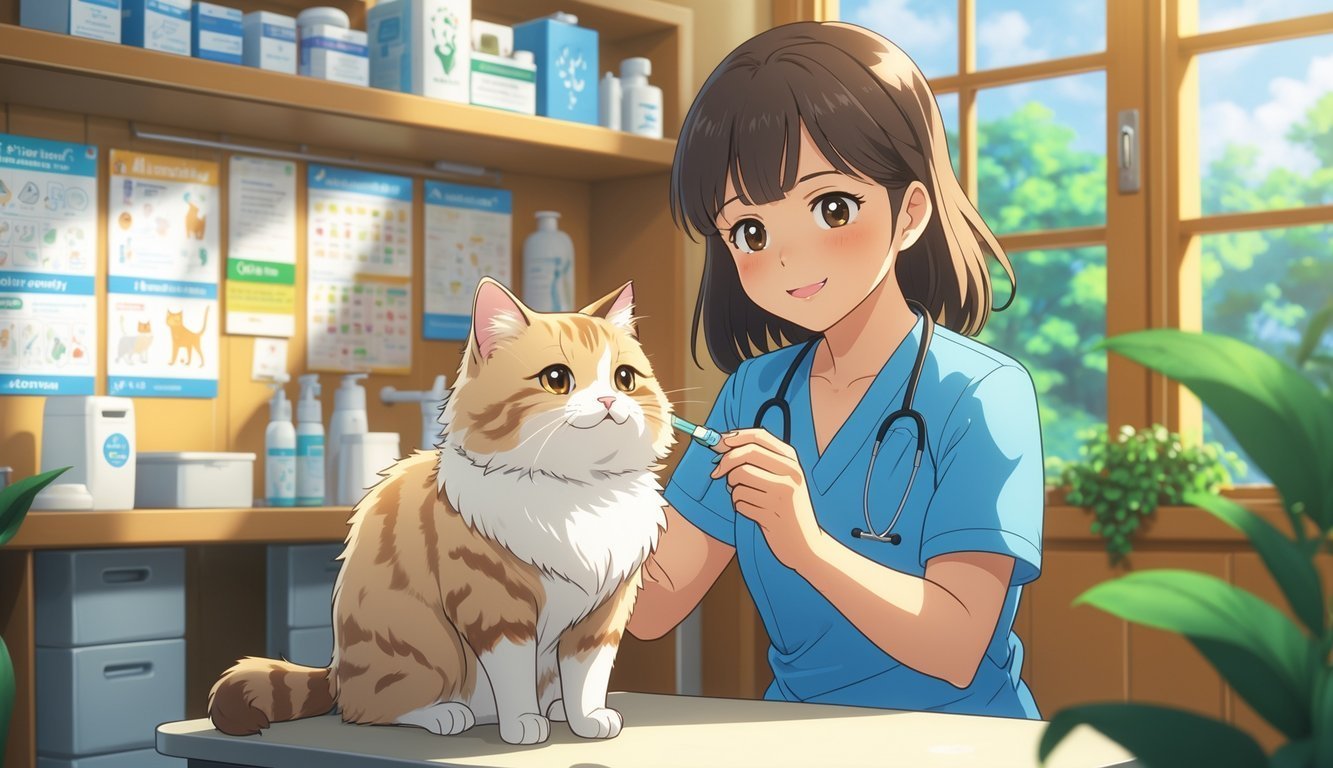
Regular vet visits keep your cat healthy. The vet checks for early signs of illness, updates vaccinations, and tracks your cat’s growth.
Kittens need several visits in their first year for shots and checkups. Once your cat is grown, a yearly exam usually does the trick unless your vet says otherwise.
During the visit, the vet checks your cat’s teeth, skin, ears, and weight. They’ll probably look for parasites and ask about diet and behavior.
Vaccines protect against serious stuff like rabies and feline leukemia. Keeping these up to date keeps your cat safe and protects other pets too.
Even if your cat seems fine, make those appointments. Cats hide illness well, so regular exams catch problems early.
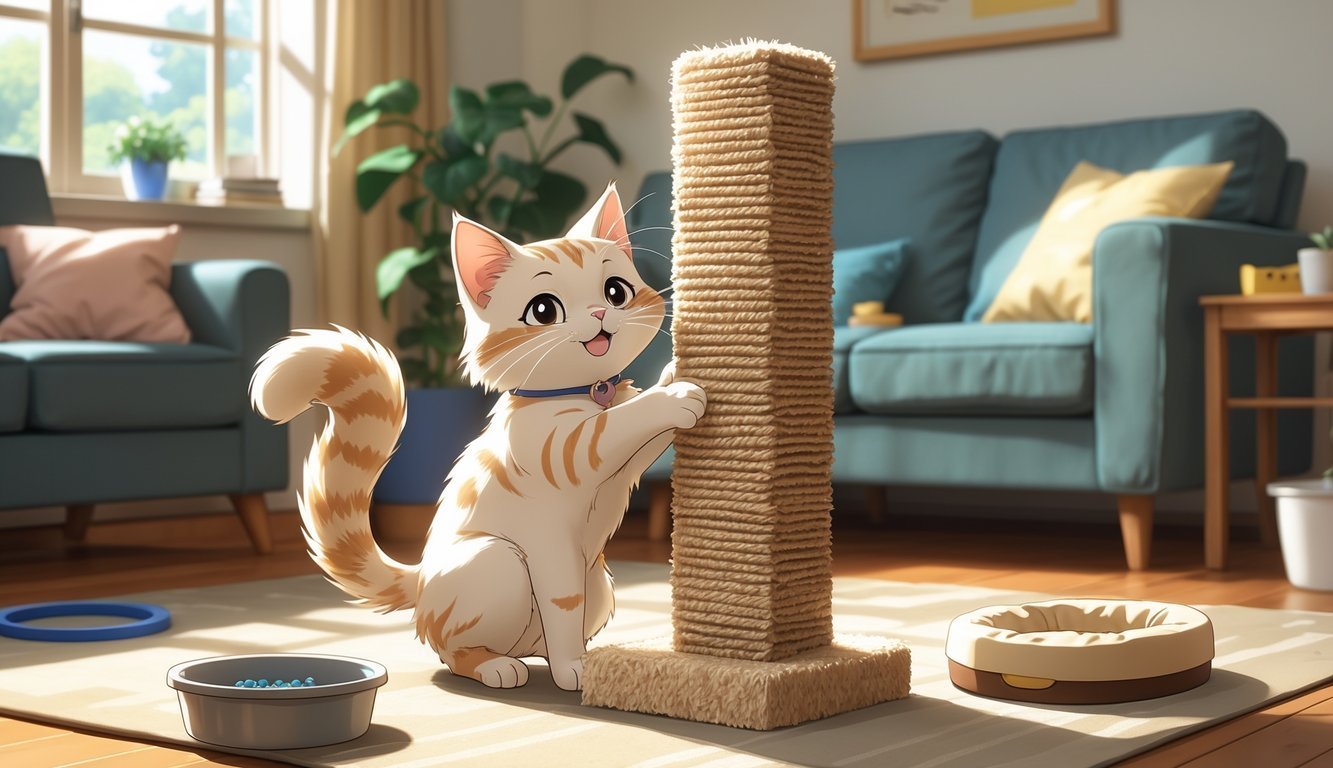
Cats need to scratch, no way around it. Scratching stretches their muscles, sheds old claw layers, and marks territory.
If you skip the scratching post, your furniture will probably pay the price. Pick a tall, sturdy post.
Cats like to stretch out fully, so don’t go for the short ones. Wobbly posts usually get ignored.
Put the post where your cat already hangs out. If they scratch the couch, set the post right there.
Sprinkle some catnip on it or play with toys around the post to get their attention. Some cats love sisal rope, others go for cardboard or carpet.
Try a few textures and see what your cat likes. If you have more than one cat, set up a few posts around the house.
That way, everyone gets a spot and your furniture stays safe.
Playtime isn’t just for fun—it keeps your cat active and helps prevent boredom. It also lets them use their natural hunting instincts in a safe way.
Interactive toys like feather wands are perfect. The Da Bird Feather Wand is a huge hit because the feathers move just like real prey.
When you control the wand, you get to set the pace and keep playtime safe. Don’t leave string toys out when you’re not around.
Short play sessions work best. Try a few minutes a couple of times a day.
Playing together also helps you bond with your cat. It’s fun for both of you, honestly.
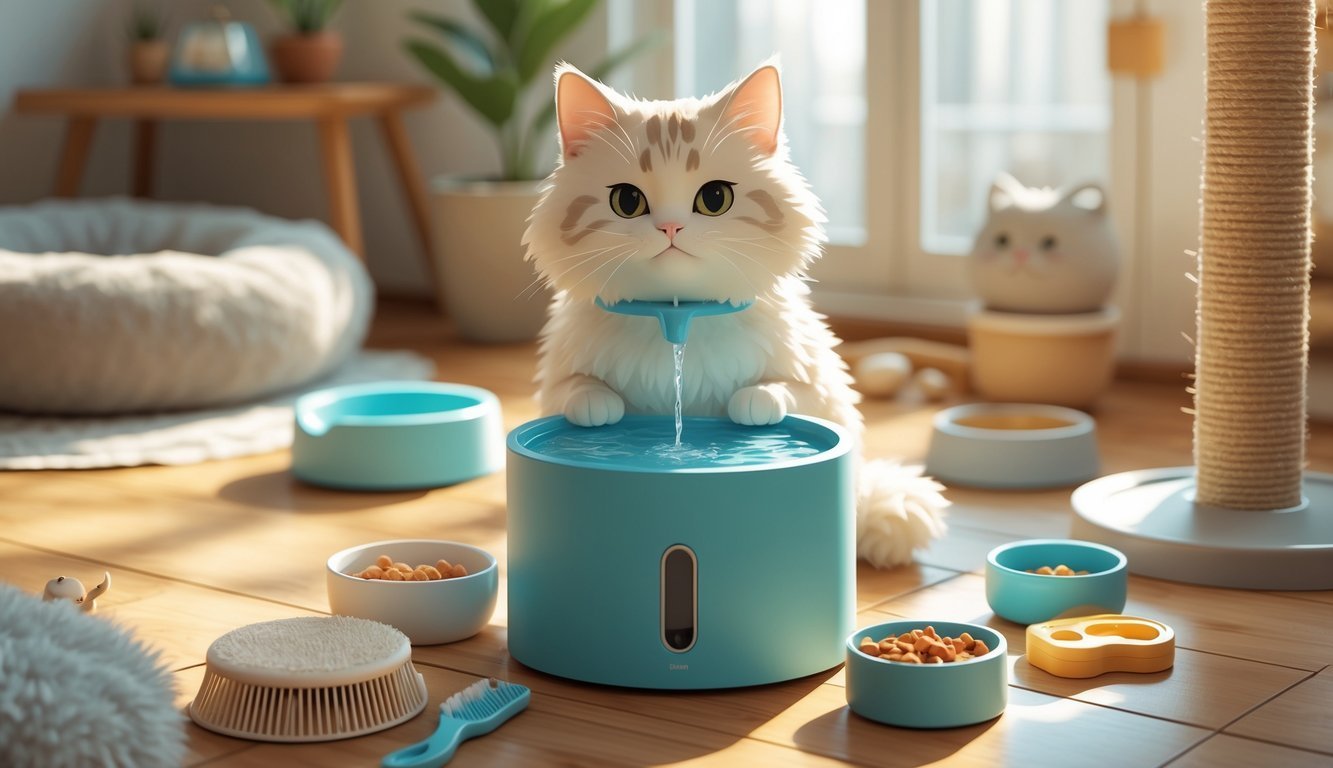
Your cat needs clean water every day, and a pet water fountain makes it easy. Flowing water stays fresher longer, and most cats actually prefer it.
A fountain encourages your cat to drink more, which helps with kidney health, digestion, and energy. This is super important if your cat mostly eats dry food.
Most fountains have filters that remove dirt and odors. Still, you should clean the fountain regularly to avoid bacteria.
Give it a quick rinse every few days and a deeper clean once a week. You can pick from stainless steel, ceramic, or plastic.
Stainless steel and ceramic are usually easier to keep clean and don’t hold odors. Choose a size and style that fits your space and your cat’s habits.
Keeping the water fresh and moving makes drinking more appealing for your cat. That little extra effort really pays off.
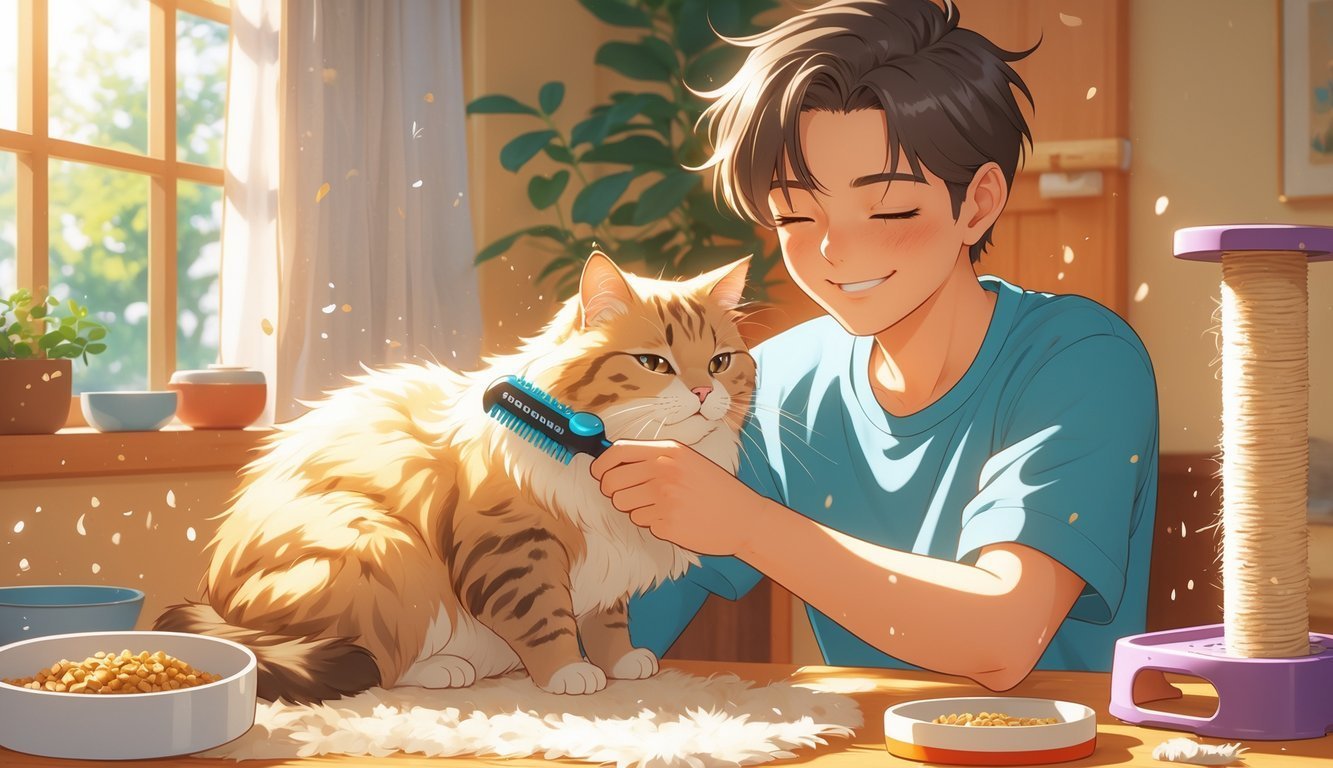
Shedding is just part of living with cats, but loose fur can take over your place fast. The Furminator de-shedding tool helps you get ahead of the mess by removing the undercoat that causes most shedding.
This keeps your cat’s coat cleaner and saves your furniture and clothes from fur piles. The Furminator reaches past the topcoat and gently pulls out loose undercoat hair.
Regular brushing also cuts down on hairballs, since your cat won’t swallow as much fur. You don’t need to use it every day.
A few times a week is usually enough, or a bit more during heavy shedding seasons. Watch your cat’s coat and adjust as needed.
Brush gently and don’t press too hard. The tool should glide without scratching.
A calm, slow approach helps your cat relax and actually enjoy grooming. Clean the Furminator after each use by removing the collected hair, so it’s ready for next time.

Cats just seem to feel safer and more relaxed when they can climb and perch up high. High spots let them keep an eye on everything, which honestly helps with stress, especially if your place is small or you’ve got more than one cat.
Try adding a cat tree with a few levels, scratching posts, and little hideouts. Some of these trees actually look pretty nice and won’t mess up your décor, which is a bonus. If you want to keep things simple or cheap, wall-mounted shelves work too.
Shelves give your cat new paths around the room. Place them near windows if you can—most cats love watching the world go by. Just double-check they’re sturdy before letting your cat leap up there.
Vertical space really helps if you’ve got multiple cats. Each cat can claim a favorite spot, so they won’t have to argue over the same area. Things stay a lot calmer that way.
Start with one tree or a couple of shelves and see how your cat reacts. If they love it, you can always add more. Before long, you’ll probably catch your cat napping or playing up high.

Lots of common houseplants are actually dangerous for cats. Lilies might be the worst—just a little bit can make a cat really sick. Every part of the lily, from the leaves to the pollen, is risky.
You might see other unsafe plants around, like sago palms, aloe vera, or some ivies. Always check if a plant is safe before bringing it home.
If your cat chews on something toxic, you could notice vomiting, drooling, or just acting tired. Lilies, in particular, can lead to kidney failure. If that happens, call your vet right away.
It’s just easier to keep toxic plants out of your house or put them somewhere your cat can’t reach. If you want greenery, pick cat-safe plants like cat grass or catnip instead.
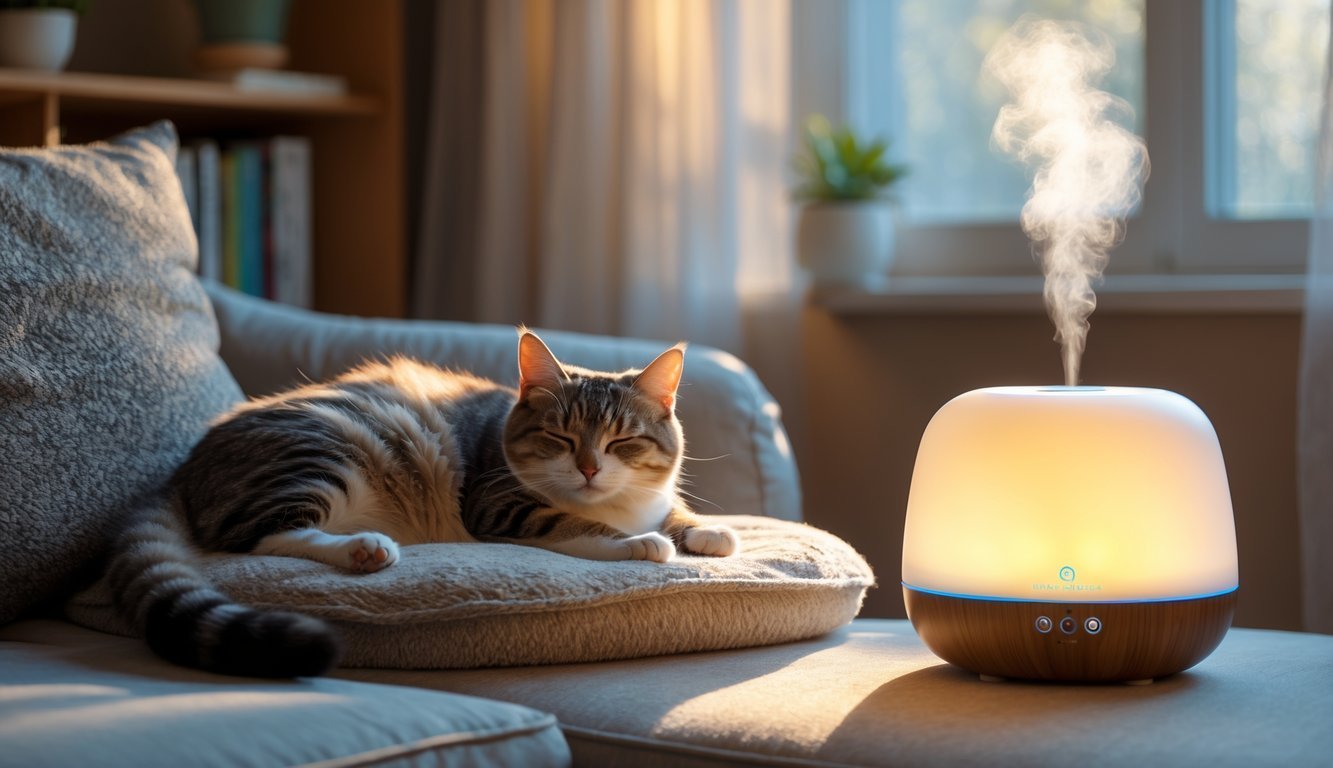
Big changes, like moving or bringing home a new pet, can stress cats out. Calming pheromone diffusers help make things feel more comfortable for them.
Feliway and similar products release synthetic pheromones that mimic the ones cats use to mark safe territory. These signals can tell your cat, “Hey, you’re okay here,” and might cut down on hiding, scratching, or spraying.
Plug the diffuser into an outlet and let it do its thing. Each refill lasts about a month, so it’s pretty hands-off.
Not every cat reacts the same way, honestly. Still, a lot of owners notice their cats seem calmer during stressful times like travel or vet visits.
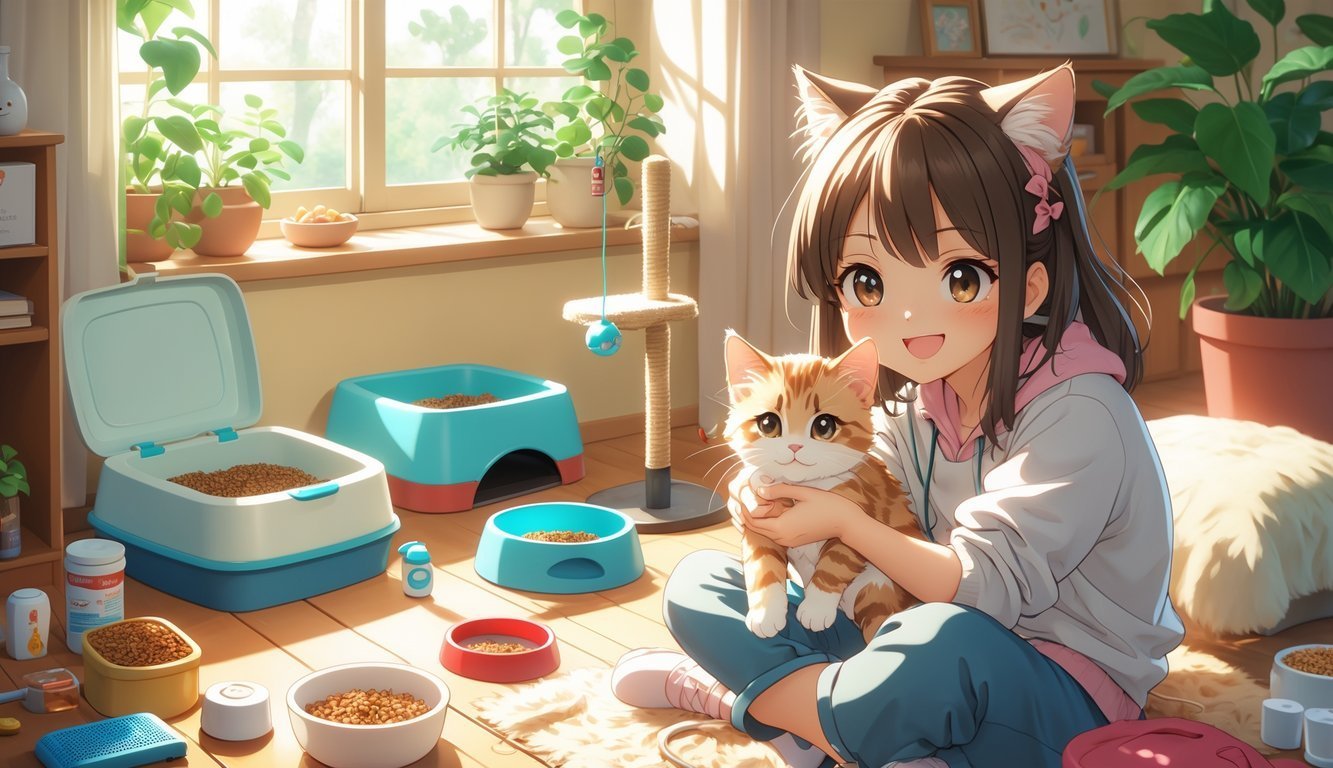
A lot of new cat owners miss some key steps that really matter for their cat’s health and happiness. Little things like skipping vet visits, feeding the wrong stuff, or not giving enough to do can lead to bigger problems later.
It’s tempting to think your cat’s fine if they look healthy, but cats are pros at hiding when they’re sick. Missing checkups means you might not catch dental problems, kidney issues, or weight changes early.
Take your cat to the vet at least once a year for a full exam, shots, and preventive care. Kittens and older cats usually need to go more often.
What regular vet visits can include:
Keeping up with vet visits saves you from bigger emergencies down the road.
Feeding the wrong food causes issues like obesity, tummy troubles, or missing nutrients. Many people stick to dry food, but cats really need protein-rich diets with enough moisture.
A mix of good-quality wet and dry food usually works best. Wet food helps with hydration and urinary health, while dry food can help with teeth if you use it right.
Common feeding mistakes to avoid:
Always give fresh water. Cats often like drinking from a fountain more than a bowl, so that’s worth a try.
Cats need more than just food and a place to sleep. Without play and things to do, they can get stressed or start acting out.
Play with your cat every day using toys that let them chase and pounce, like feather wands or laser pointers. Scratching posts, cat trees, and puzzle feeders keep them busy and happy.
Ways to enrich your cat’s life:
A well-socialized, enriched cat is usually more relaxed and confident—and honestly, it’s just more fun for both of you.
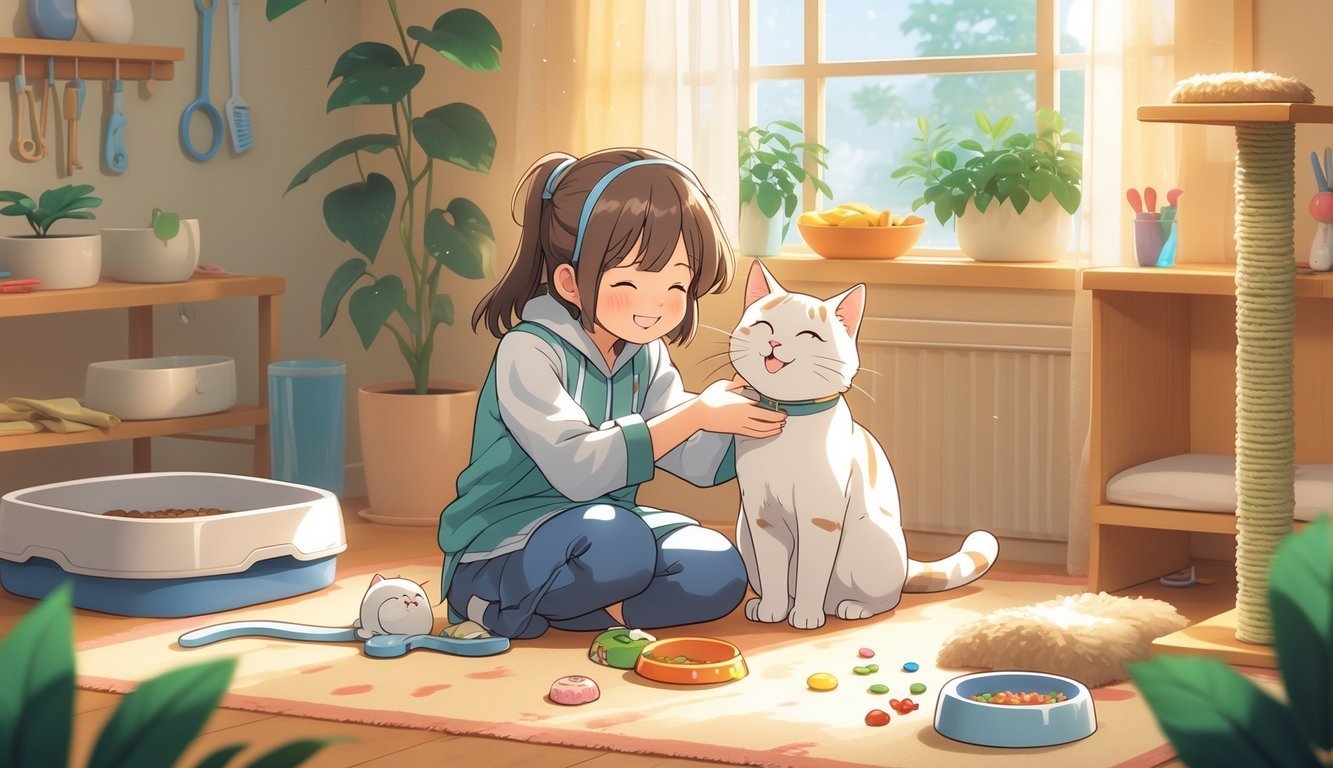
Cats really need a space where they feel safe and know what to expect. A calm home and steady routine go a long way toward keeping them healthy and happy.
Cats relax more if they have places to hide and nap. Set up cozy spots like covered beds, boxes, or a perch where your cat can get away for some quiet.
Keep dangerous stuff out of reach. Tuck away cords, remove toxic plants, and store cleaning supplies where your cat can’t get to them. That way, you avoid accidents and make your place safer.
Give your cat things to do. Scratching posts, cat trees, and interactive toys help keep boredom away. Rotate toys every few days to keep things fresh.
Here’s a quick checklist:
When your cat feels safe and has options, they’ll settle in faster and show more relaxed behavior.
Cats really do best when life feels predictable. Try to feed your cat at the same times every day, and always keep their water bowls filled with fresh water. This routine helps them feel safe and usually stops them from begging or stressing out at mealtime.
Scoop the litter box every day. Most cats will avoid a dirty box, and honestly, cleaning it regularly lets you spot any health changes early.
Make sure you set aside time to play with your cat each day. Grab a wand toy or toss a ball—anything that gets them moving and lets them act out their hunting instincts. Even just a few minutes can keep your cat active and help with their weight.
Grooming matters too. Brush your cat to cut down on shedding and hairballs. If you’ve got a long-haired cat, daily brushing works best to stop mats from forming.
Cats notice when you stick to a routine. It gives them comfort and, honestly, helps you both feel more connected.